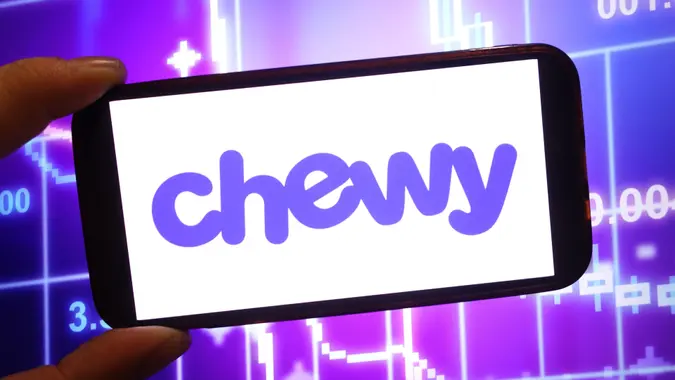Best Stocks Under $10 To Buy Today

Commitment to Our Readers
GOBankingRates' editorial team is committed to bringing you unbiased reviews and information. We use data-driven methodologies to evaluate financial products and services - our reviews and ratings are not influenced by advertisers. You can read more about our editorial guidelines and our products and services review methodology.

20 Years
Helping You Live Richer

Reviewed
by Experts

Trusted by
Millions of Readers
Investing is a perfect option for those looking to put their money to work and build wealth over time. But it’s not unusual to come across stocks like Apple, which trades for hundreds of dollars per share.
These high price tags can become a barrier for many. The good news is that there are plenty of stocks under $10 that you can pick up and use to build the foundation of your portfolio.
Here are our picks for some of the best stocks under $10 to buy today and add to your upstart investment portfolio.
Best Stocks Under $10 To Buy
Stocks under $10 typically represent small companies that make for riskier investments. Nonetheless, with a bit of research, it’s possible to find gems in this price range.
Here are our picks for stocks under $10 to grab while you can:
| Company | Ticker | Price |
|---|---|---|
| Amplify Energy | NYSE: AMPY | $6.96 |
| InfuSystems Holdings Inc. | NYSE: INFU | $9.24 |
| Immersion | NASDAQ: IMMR | $8.66 |
| Oatly Group AB | NASDAQ: OTLY | $.70 |
| MiMedx Group | NASDAQ: MDXG | $9.22 |
| Laird Superfood Inc. | NYSE: LSF | $8.37 |
| Arcadia Biosciences | NASDAQ: RKDA | $2.65 |
| Stryve Foods | NASDAQ: SNAX | $.95 |
| DocGo Inc. | NASDAQ: DCGO | $4.12 |
1. Amplify Energy (NYSE: AMPY)
Amplify Energy is a Houston-based oil and natural gas producer and developer that operates in Oklahoma, the Rockies, Texas, Louisiana and federal waters off the Southern California coast.
Why We Picked It: According to an energy sector research brief from Fidelity, elevated oil prices and increased investments in energy production should benefit oil producers in 2024. Those oil prices and better-than-expected financial results in the first quarter led Amplify to increase its 2024 full-year guidance for revenue and free cash flow.
Pros
- Analysts’ average 12-month price target is 44% higher than the current share price.
- Analysts watching the stock consistently rate it a “buy.”
Cons
- Analysts estimate negative earnings growth for 2024.
- Analysts expect Amplify to underperform compared to other oil/energy companies.
2. InfuSystem (NYSE: INFU)
InfuSystem is a medical devices company that sells, leases and repairs infusion pumps used in oncology, pain management and wound care. The company’s products and services have reached over 1 million patients in almost 5,000 customer locations.
Why We Picked It: The medical devices industry is expected to grow more than 5% per year to nearly $800 billion by 2030, according to market research from KPMG, an auditing, tax/legal and advisory company. InfuSystem’s growth positions it to profit from that trend.
Pros
- InfuSystem’s earnings and earnings growth compares favorably to similar companies’ earnings and growth.
- Profits, revenues and earnings are growing on a year-to-year basis.
Cons
- InfuSystem has missed earnings expectations for two of the past three quarters.
- Shares are down year to date and over one, three and five years.
3. Immersion (NASDAQ: IMMR)
Immersion is a sensory technology company that specializes in haptics. Haptics are the touch feedback features that create the sensation of pressing a button on your phone and make your game controllers rumble.
Why We Picked It: The haptics market is expected to grow from $2.99 billion in 2023 to $7.31 billion by 2030, according to Fortune Business Insights. Experts predict demand will increase not only in consumer electronics but also in the automotive, aerospace and healthcare industries. Immersion is one of a handful of U.S. companies with a strong presence in the space.
Pros
- Analysts are bullish on the stock.
- The company consistently beats earnings expectations.
Cons
- Immersion has strong U.S. competition from Texas Instruments
- Earnings are expected to fall next year.
4. Oatly Group AB (NASDAQ: OTLY)
Oatly Group produces oat-based dairy products for a variety of uses, including plant-based yogurt, frozen desserts, cooking products and to-go drinks.
Why We Picked It: Although Oatly is a defensive consumer staple stock, it debuted during the pandemic. Following a short rise after shares hit the market, prices declined steeply for nearly 10 months, dropping from $28 in June 2021 to less than $4 in April 2022. Things finally appear to be turning around. If analysts are right, share prices could more than double in the next 12 months.
Pros
- Oatly is implementing a four-pronged strategy to reduce costs, expand the reach of its brand, make more efficient use of resources and strengthen execution.
- The company presented a strong earnings report for Q3 2024.
Cons
- Oatly lost $416.87 million last year, and earnings per share decreased.
- The stock’s beta score of 2.09 indicates 2.09 times as much volatility as the average stock.
5. MiMedx Group (NASDAQ: MDXG)
MiMedx Group develops advanced wound- and surgical-care products, including the No. 1 amniotic skin substitute.
Why We Picked It: MiMedx has a strong position in a niche market within the defensive healthcare sector. Over 2 million patients have received its allografts, and its focus on payer insurance coverage has resulted in over $300 million in reimbursements. Analysts expect earnings growth next year, and their average price target is over 32% above the current share price.
Pros
- MiMedx consistently exceeds revenue and earnings estimates.
- The company’s growth measures are paying off with improvements in net sales and profit margin.
Cons
- Regulatory issues pose challenges with some of MiMedx’s products.
- MiMedx is profitable but doesn’t pay dividends.
6. Laird Superfood Inc. (NYSE: LSF)
Laird Superfood makes healthy plant-based foods using clean, functional ingredients. Consumers can purchase Laird products at select grocery stores, including Harris Teeter and Whole Foods, on Amazon.com or directly through the company’s subscription plan.
Why We Picked It: The functional food market is expected to reach $349.22 billion this year and $488.31 billion by 2029, according to Precedence Research. That gives Laird plenty of room for growth, and analysts are taking notice. Several investment houses watching the stock have maintained or reiterated “buy” recommendations over the last several months.
Pros
- The company has low debt.
- Laird has easily surpassed earnings estimates in each of the last four quarters.
Cons
- Laird is not yet profitable.
- The company’s ultra-low $90.37 million market cap makes this an especially risky investment.
7. Arcadia Biosciences (NASDAQ: RKDA)
Arcadia is an agricultural biotech company that produces high-fiber pasta products and pancake mixes and coconut water.
Why We Picked It: Although it produces food, Arcadia operates in the materials sector, which is strongly influenced by economic cycles. Fidelity’s materials brief for 2024 notes that this sector typically does well early in new economic cycles, which the U.S. could enter if it continues to avoid recession.
Arcadia stocks, like the materials sector overall, performed poorly last year, but a positive first-quarter earnings release sent shares soaring. Analyst price targets average $9, which is 149% above the Nov. 14 closing price of $3.69.
Pros:
- Arcadia is rapidly expanding distribution, and it recently introduced its macaroni and cheese products on Amazon.com.
- The company turned a profit in the second quarter.
Cons
- The company has a small product line.
- A lingering risk of recession could hamper Arcadia’s near-term growth.
8. Stryve Foods (NASDAQ: SNAX)
If this list seems heavy on food manufacturers, the reason is that inexpensive stocks are often for companies with small capitalizations, and they tend to be clustered in a handful of industries — like food. In this case, the food is snack food, including sugar-free air-dried jerky, biltong, charcuterie slabs and training treats for pets. Stryve distributes its products through a variety of retail stores and directly to consumers through its website, Amazon.com and Walmart.com.
Why We Picked It: The healthy snacks market is $102.95 billion strong, according to Statista, and it could grow nearly 50% by 2030. While it would be imprudent to make investing decisions based solely on Stryve products’ popularity with consumers, demand is so high for some items that the company is having trouble shipping orders on time. What’s more, the stock is generating positive buzz in the financial press, and analysts say it has a 304% upside.
Pros
- Stryve’s transformation strategy, which should be fully implemented before the end of the year, is paying off with improved financials.
- The company utilizes strong distribution channels.
- Stryve recently grossed $2.9 million in a stock offering
Cons
- Stryve faces competition from well-known brands like Real Good Food and Petz.
- Shares are down 68% over the past year.
9. DocGo (NASDAQ: DCGO)
Working with partner hospitals and health systems, state and local governments, physician offices, health plans and businesses, DocGo delivers mobile healthcare directly to communities. It provides urgent care, preventative services and chronic condition support to patients in their homes, at work and virtually. The company also provides remote patient monitoring and medical transportation services.
Why We Picked It: DocGo is a medical services provider, but it’s highly driven by data and technology. For example, it uses proprietary AI-powered computer-aided dispatch software to run most of its mobile health operations. Although it faces competition from companies like Sharecare, DocGo serves a much larger market and could establish itself as a silo in the mobile healthcare delivery and technology space.
Pros
- Insiders acquired shares earlier this year, which could indicate that the stock is undervalued.
- The company recently reported strong year-over-year increases in total revenue and net income.
Cons
- While analysts expect massive earnings growth this year, they expect growth to decline next year.
- The stock has performed poorly over the last year, falling 33.52%.
Final Take
Although the stocks above represent some of the best stocks under $10, they’re also quite risky — the price you pay for the opportunity for significant growth.
If you’re comfortable with the risk and any losses that might result, investing in these companies can help diversify your portfolio.
However, they should comprise only a small percentage of your total stock holdings.
Joshua Rodriguez contributed to the reporting for this article.
Data is accurate as of Nov. 21, 2024, and is subject to change.
Our in-house research team and on-site financial experts work together to create content that’s accurate, impartial, and up to date. We fact-check every single statistic, quote and fact using trusted primary resources to make sure the information we provide is correct. You can learn more about GOBankingRates’ processes and standards in our editorial policy.
- Arcadia Biosciences. 2024. "Arcadia Biosciences (RKDA) Announces First Quarter 2024 Financial Results and Business Highlights."
- Yahoo Finance. 2024. "Earnings Update: Oatly Group AB (NASDAQ:OTLY) Just Reported Its First-Quarter Results And Analysts Are Updating Their Forecasts."
- Fidelity. 2023. "Energy: A brighter 2024."
- Amplify Energy. 2024. "Amplify Energy Announces First Quarter 2024 Results and Improved 2024 Guidance."
- Yahoo Finance. 2024. "Laird Superfood, Inc. (AMEX:LSF) Q1 2024 Earnings Call Transcript."
- Statista. "Healthy snacks market value worldwide between 2021 and 2030."
- Fidelity. 2023. "Materials: Ready for a potential economic rebound."
- Precedence Research. "Functional Food Market."
- World Economic Forum. 2024. "Space is booming. Here's how to embrace the $1.8 trillion opportunity."
 Written by
Written by  Edited by
Edited by 

























